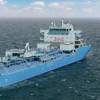Drewry’s Forecast Warns Carriers
Drewry believes that the industry has emerged from the global recession with both carrier profitability and demand figures bearing this out, but still ask whether or not the industry has learnt anything? The fact that no major companies went to the wall still seems to have insulated the industry from the despair of 2009 and there is now the feeling that perhaps the dark days did not happen. In essence, Drewry observes that it is back to normal operating conditions.
A number of carriers have come back into the newbuild market, believing it is the right time to buy again despite the fact that bank financing is now much more circumspect. Hapag-Lloyd, CSAV, OOCL and Hamburg Sud have all placed significant orders since September and we are awaiting AP Moller Maersk to confirm its supposed order for a number of huge 18,000 teu vessels from a South Korean yard which will take the industry into new territory. Other players including Hanjin, CSCL and Evergreen have indicated that they will also place further orders and a new breed of Greek owners, attracted by potential healthy returns when compared to the now moribund tanker and bulk markets, are coming to the fore.
Financial prudence is disappearing
Drewry points out that in 2010, ocean carriers acted prudently with a keen eye on the supply/demand balance and most importantly on profitability. However, as the year ended, all the indicators pointed to the fact that the largest carriers are now gearing up for a fight for market share in 2011 which will inevitably lead to a decline in freight rates.
Neil Dekker, editor of the Drewry Container Forecaster, said: “Unfortunately, the desire to maintain market share seems to be the primary driver in the east-west trades at the moment since carriers have resolutely refused to take out capacity from the market place despite the fact that headhaul utilisation factors were in the low 80’s (mid-December) and spot rates were falling steadily week by week. Although carriers have released record or near-record financial results for 3Q, this is not a time for complacency, concentrating on market share instead of profitability. The trends being displayed are the same as have been evident in recent times and are usually the precursor of a downwards spiral in the market.”
He added: “Perhaps the biggest carriers are happiest with no long-term profitability as long as they have market share. However, the utopia of freight rate stability sought by shippers seems a long way off if carriers abandon their short-lived prudence and profitability.”
Rates to fall in 2011
In the latest Container Forecaster Drewry projects that the global fleet forecast will grow by 8.5% in 2011 and much of this capacity in the 8,000+ teu sector, cautioning that carriers will need to be extremely careful in their deployment strategies if they are not to upset the supply/demand scenario. However, current behaviour suggests lines are reluctant to shed excess tonnage and we do not expect the same intensity of lay ups as previously seen. Drewry’s projection is that average east-west rates (excluding fuel) will fall by 7% next year and after a strong rebound in 2010, carrier profitability will fall back into the $8 billion range, although this could be considerably lower if carriers’ pricing and capacity discipline weakens further.
Drewry indicates, one noticeable factor is the rise of the smaller carriers in the east-west trades lanes. Although the smaller carriers are deploying relatively small ships, the biggest players have now become more wary of them and no longer wish to relinquish market share. This time round, carriers have already trimmed all the fat they can from their operations and any future downturn could potentially be more telling.
Dekker cautions that, “Just before the crucial contract re-negotiation period, carriers are passing any aces to their customers once again, but shippers maintain that they do not necessarily just want low rates – they also want a sufficiently reliable service. The Federal Maritime Commission is also suggesting that both parties talk to each other more, but unfortunately, it seems that some carriers are not necessarily heeding this message. However, it is also time for shippers to bring more detail and information to the negotiating table and anecdotally we hear that this process is starting to happen.”













